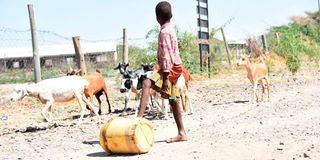Children worst affected by climate change

A gilrl pushes a jerrican of water at Lowareng’ak village in Turkana County on October 12, 2022 amid a biting drought.
On Friday morning, mothers and children gathered around hoping to find relief food as volunteers from Save the Children mobilised the hungry crowd, deep in Kaakel village in Turkana County.
The joint medical outreach activity in collaboration with the county government was visiting far-flung areas to determine the extent of malnutrition and put the children at risk under treatment.
Two-year-old Mala Emoni underwent a checkup to determine how malnourished he is. His weight was under the recommended weight for a child of his age.
Using the Mid-upper Arm Circumference (MUAC), a simple coloured plastic strip is used on children five years old and below to determine whether or not they are malnourished.
Mala’s measurements landed in the orange zone indicating that he is moderately malnourished.
“He is my second born. I have five children,” said the mother as she fed him a pack of Plumpy’nut used for treatment of severe acute malnutrition.
Climate activist Vanessa Nakate said in a recent report how she saw the disaster play out first hand when she visited Northern Kenya.
“With four consecutive failed rainy seasons and a drought touted as the worst in 40 years, there is insufficient food and water. In the north of Kenya, I spoke to mothers and met children at risk of dying from severe acute malnutrition. It was devastating and that it is avoidable is infuriating,” she said.
UNICEF’s August update revealed that 222,720 children in Kenya are suffering from severe acute malnutrition while 884,464 are facing acute malnutrition.
Since December 2021, the numbers increased by at least 100,000 showing that more children became vulnerable to starvation this year alone.
“The children who are least responsible for climate change are bearing its biggest costs. Africa is responsible for less than 4 per cent of global emissions but is suffering some of the climate crisis most brutal impacts. Lives are being lost from preventable causes because the world is acting too slowly on mitigation and not providing enough support for adaptation,” Nakate said.
As COP27 kicks off in Sharm el-Sheikh in Egypt today, all members of the Conference of Parties (COP) are required to submit updated National Determined Contributions (NDCs) as required after every five years.
NDCs serve as the country-specific building blocks that build towards these collective goals. Parties are required to pursue domestic mitigation (emissions reduction) measures with the aim of achieving the mitigation commitments in their NDCs.
In addition, some countries also use NDCs to articulate their adaptation plans and finance requirements.
Neither Kenya’s NDCs nor National Adaptation Plan has specified a plan to protect children from the effects of climate change.
The report also revealed that over 400,000 learners have been affected by the ongoing drought.
Some 66,000 of them are not attending school due to the effects of the drought.
The main reasons that forced them to be absent from school included the increased migration of families in search for water, reduced sanitation in school, absence of school meals, inability to pay school fees and children caring for livestock.
Additional reporting by Sammy Lutta





